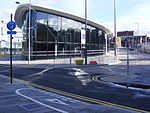Number One Riverside

Number One Riverside is a multi-use public building in Rochdale, Greater Manchester, England. It incorporates Rochdale Metropolitan Borough Council civic offices and customer service centre, Rochdale Central Library as well as conference facilities for community use and office space for third parties. The publicly accessible ground floor has restaurant and café spaces overlooking the River Roch. It was designed by FaulknerBrowns Architects and opened to the public in March 2013. The contemporary building was designed to be energy efficient and incorporates renewable and low carbon technology including a biomass boiler, photo voltaic panels to generate electricity and solar panels to help heat water. Its green roof was designed to harvest rainwater and provide insulation. The development of Number One Riverside enabled the council's estate to consolidate from 33 different sites into one building.
Excerpt from the Wikipedia article Number One Riverside (License: CC BY-SA 3.0, Authors, Images).Number One Riverside
Smith Street,
Geographical coordinates (GPS) Address Website Nearby Places Show on map
Geographical coordinates (GPS)
| Latitude | Longitude |
|---|---|
| N 53.617 ° | E -2.1537 ° |
Address
Rochdale Central Library
Smith Street
OL16 1XU , Wardleworth
England, United Kingdom
Open on Google Maps









